How to report a website for scamming: 7 essential steps
Have you found a site with terrible grammar or deals that sound too good to be true? In this guide, learn how to report a website for scamming and how security software like Norton™ 360 with LifeLock™ Select can help protect against hackers, malware, identity theft, and fake sites that try to steal your passwords and compromise your accounts.

Scammers use fraudulent websites to manipulate users, acquire personal and financial information, and infect devices with malicious software. You might encounter imitations of social media sites, deceptive online stores, or clone websites impersonating brands you trust.
If you land on a scam website, follow these seven essential steps to report the site for scamming to help protect yourself and other users online.
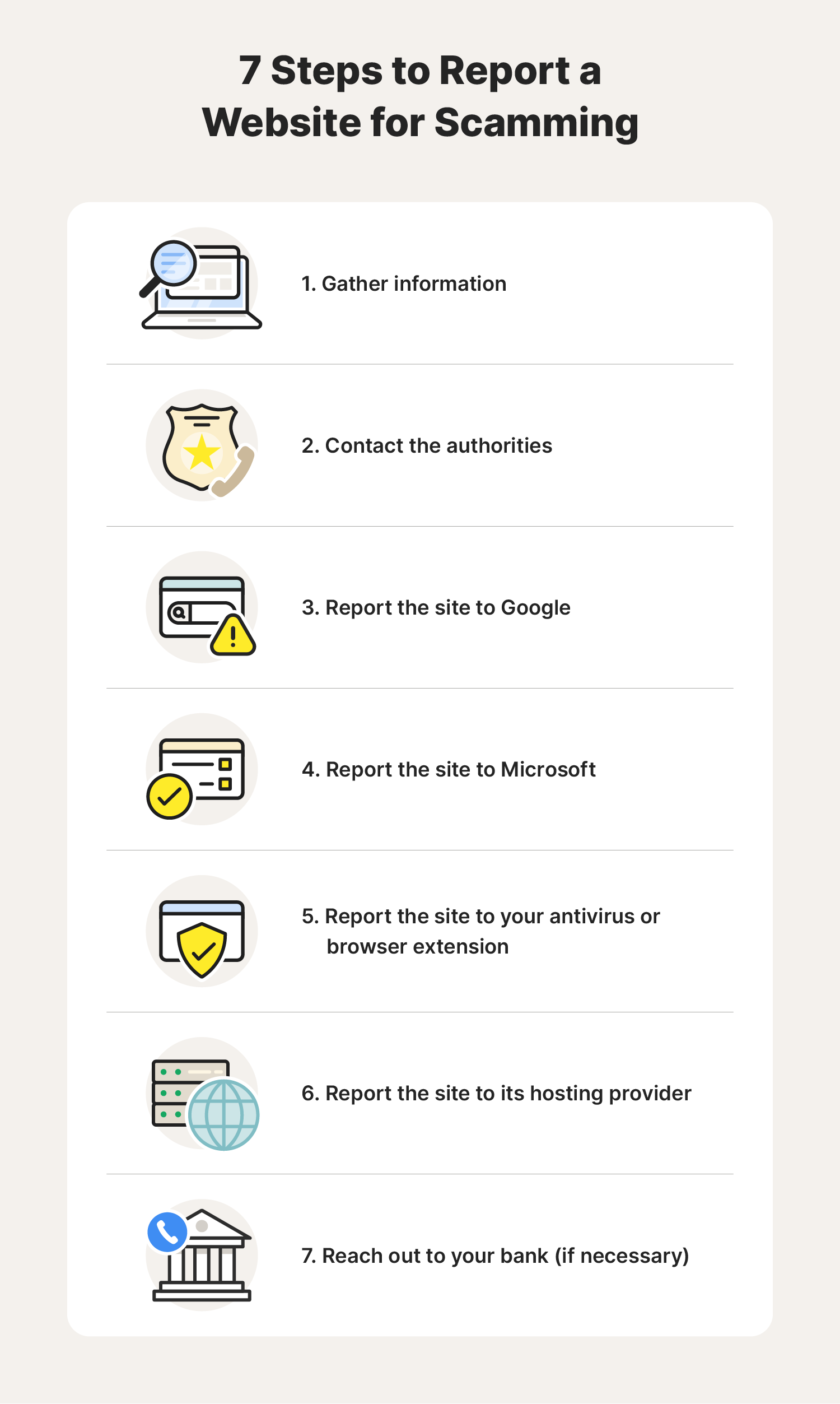
1. Gather necessary information
Before you file a report about a website scam, gather the information you need to submit the report. Each governing body may have slightly different requirements, but you’ll usually need to provide:
- The site’s URL
- Contact info for the site, including names, phone numbers, emails, or social media accounts
- A description of your experience and the nature of the scam
- The date and amount of any fraudulent transactions
- The method used to process any transactions
- Your contact information
In some cases, you can file an anonymous report, but providing your contact information helps authorities reach you if they need more information.
2. Contact relevant authorities
Reporting scam websites helps government agencies and law enforcement officials bring cybercriminals to justice by identifying patterns of cybercrime and building cases against scammers. Plus it lets them educate the public with their findings. Make sure you report cybercrime incidents to the appropriate authorities as soon as possible.
Here’s how to report scam websites to relevant agencies:
Federal Trade Commission (FTC)
Inform the FTC about any fraudulent or scammy sites by filing a report on their website. The FTC uses submitted reports to build cases against scammers and identify patterns in fraudulent behavior to inform future investigations.
The FTC also shares the details of reported incidents with law enforcers nationwide, providing evidence to support investigations of fraud, scams, and bad business practices.
Internet Crime Complaint Centre (IC3)
The IC3 operates under the FBI and encourages victims of all cybercrime, including website scams, to file complaints with the agency. You can file a complaint on the IC3 website, and trained analysts will then forward relevant information to local, state, federal, or international authorities depending on the nature, scale, and impact of the incident to help inform their investigations.
Local authorities
After reporting the scam website to the federal agencies listed above, report fraudulent websites, online stores, pharming attacks, and other cybercrimes to your local authorities. Filing a report with your police department’s fraud division may help you if you need to file an insurance claim or prove to your bank that you encountered a website scam.
3. Report the site to Google
Reporting a fraudulent, scammy, or fake website to Google can help remove the site from Google search results. If Google determines that a reported website violates its policies or conducts illegal activity, it will restrict or remove access to the site.
Google has three separate forms for incidents related to spam, malware, and phishing, so make sure you choose the correct form.
Report spam, deception, or low-quality content
If a website violates Google’s spam policies you can report it. Look out for websites that fail to deliver on their promise such as advertising a service or product and not actually providing it upon payment. Reporting them to Google can help prevent the fraudulent website from scamming others.
Use Google’s spam report form to report spammy, deceptive, or low-quality sites. You’ll have to provide the following before you can submit your report:
- The page URL
- What’s wrong with the page (pick a category)
- Details to help Google understand the issue
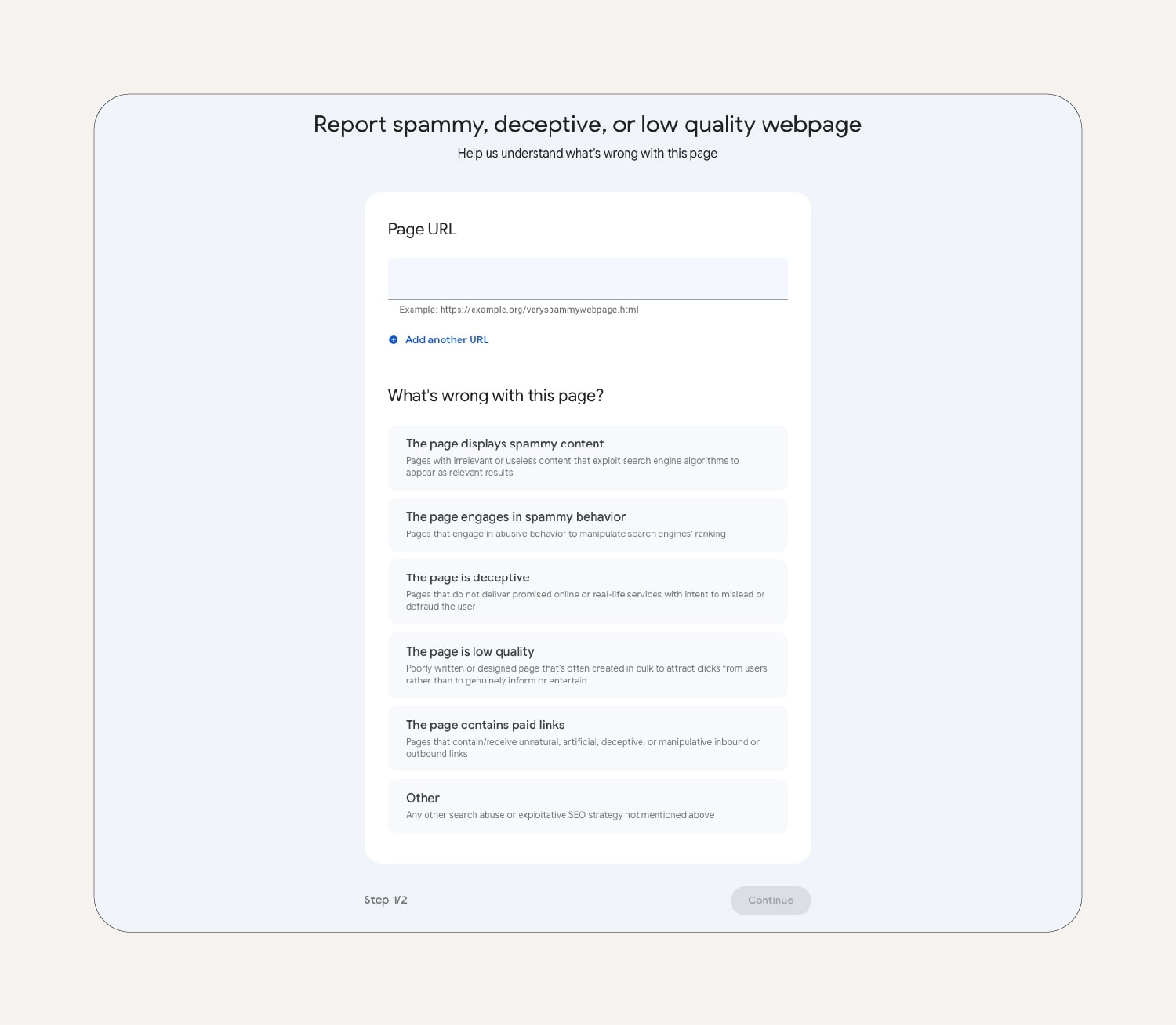
Once you submit your report, Google will analyze the information provided, using the details of your incident report to improve search algorithms. Google may also manually remove the site from search results or contact the site’s web admin if the analysts believe the website is legitimate but violating spam policies.
Report malicious software
A site that hosts or is infected with malicious software (malware) threatens user safety and should be reported. You can report sites you think contain malware using Google’s report malware form. To submit the form, you’ll need to follow these steps:
- Enter the site’s URL
- Complete the CAPTCHA
- Describe relevant details about the malware
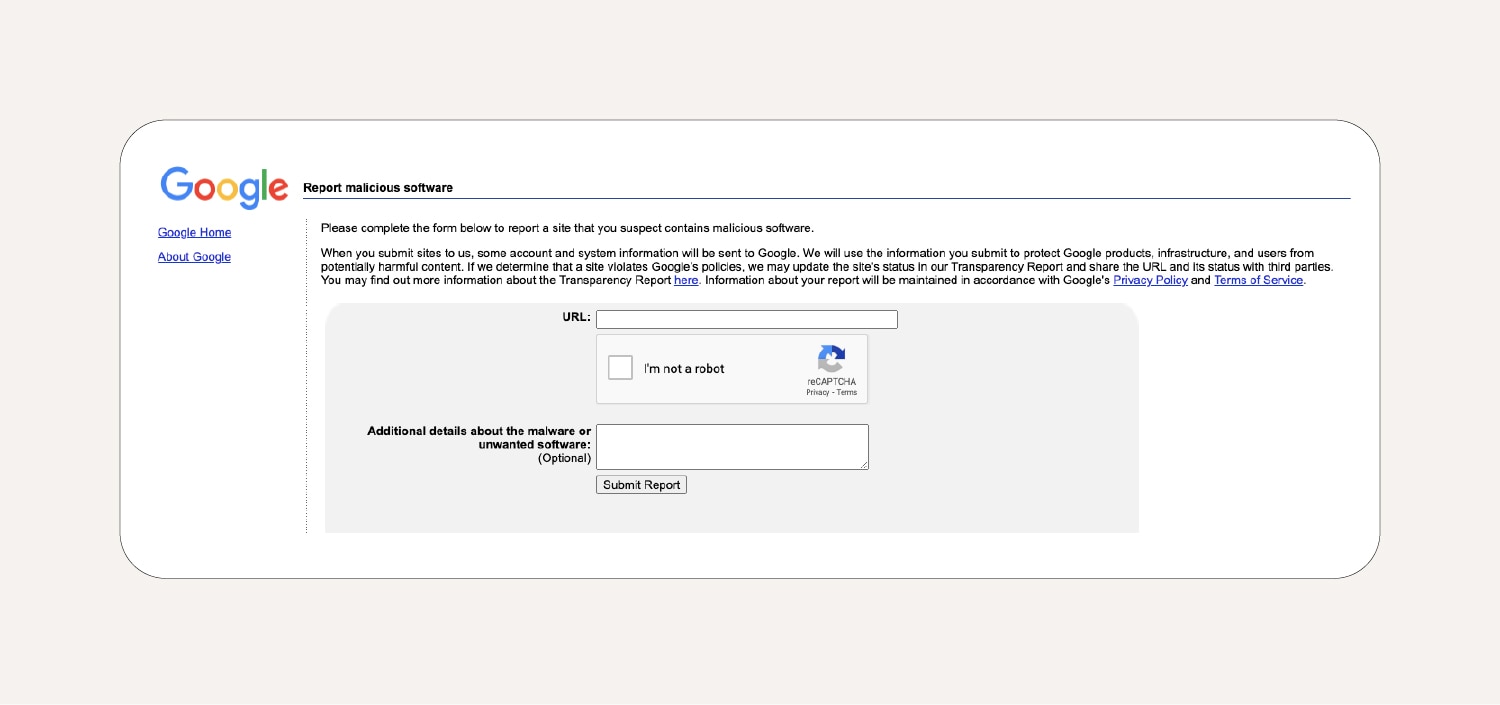
If malware has infected your device, learn what to do after a malware attack to protect yourself against identity theft and other potential fallouts.
Report phishing
Phishing is a way cybercriminals attempt to deceive users into providing personal or financial information. Use Google’s phishing report form to report a scammy or fake website attempting to steal sensitive information or data. You’ll need to follow these steps:
- Provide the page URL
- Complete the CAPTCHA
- Describe details about the phishing attempt
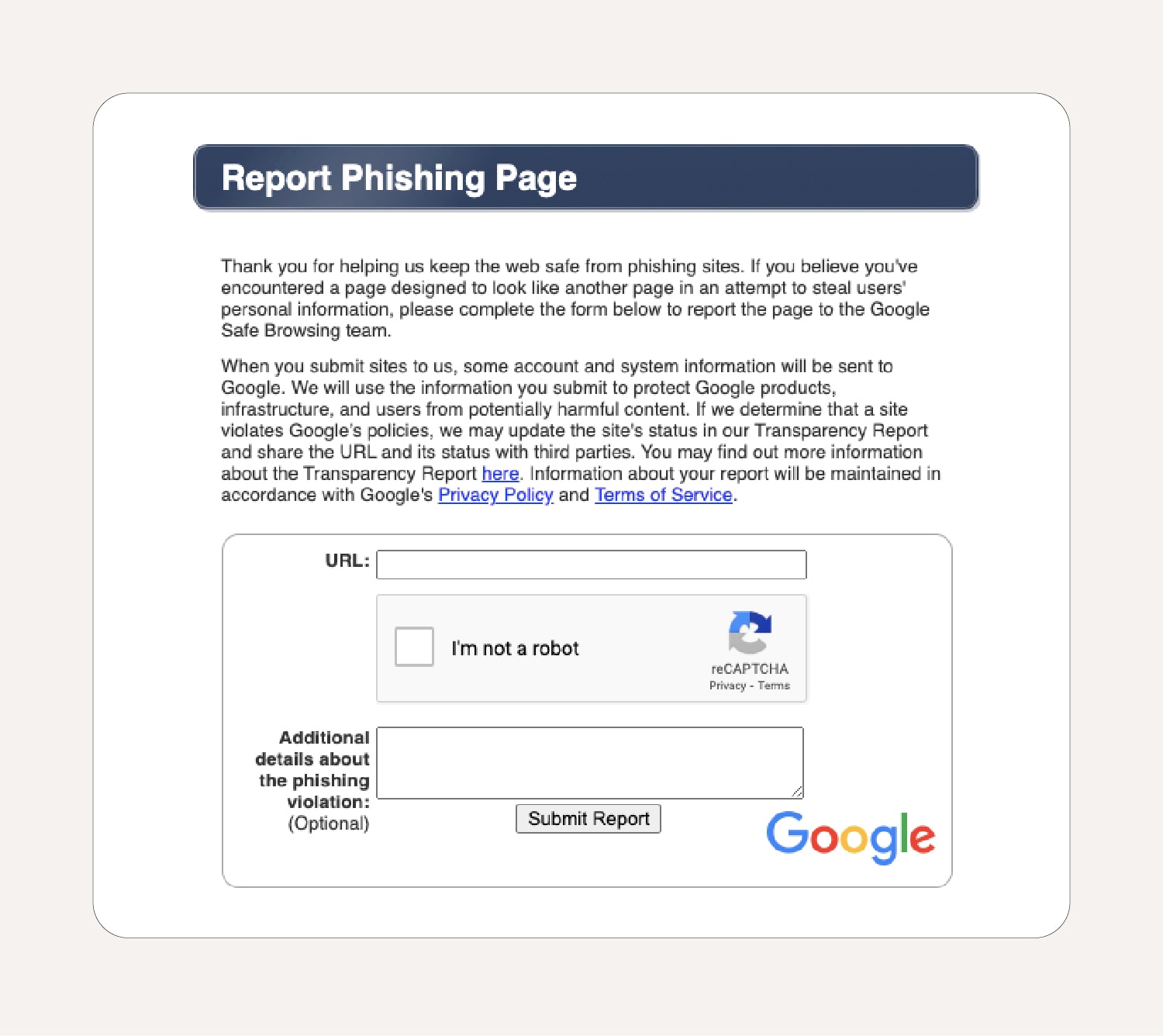
You can help protect yourself from phishing attempts by recognizing the signs and following good cyber hygiene practices like using secure passwords and two-factor authentication.
4. Report the site to Microsoft
You should report scam websites to Microsoft to block them in Outlook, Microsoft Edge, Yahoo, and Bing. Once you submit your report, Microsoft will evaluate the details and determine a course of action, such as removing the site from search results and blocking emails from addresses, including the reported URL.
When filling out this form, you’ll need to:
- Provide the site’s URL
- Identify phishing or malware as a threat to the site
- Choose the primary language of the site
- Complete the CAPTCHA
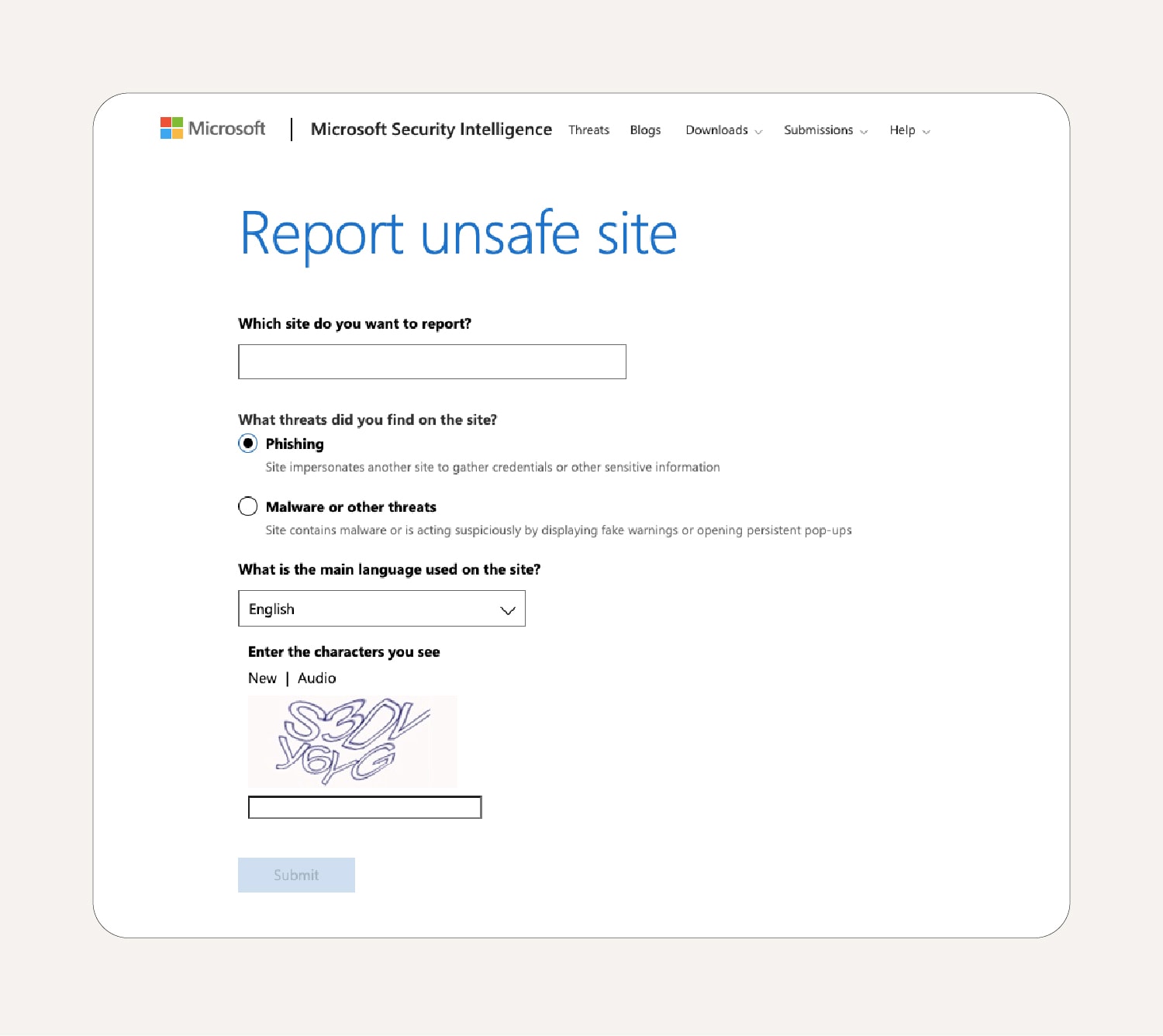
5. Report the site to your antivirus or browser extension
If you’ve found a suspicious website and use good antivirus software or a browser extension, you can report it to the company so they can block it going forward. If you use Norton antivirus software, report the site to Norton with the following information:
- Your email address
- The site’s URL
- Description of how this site is scammy or otherwise suspicious
- Complete the CAPTCHA
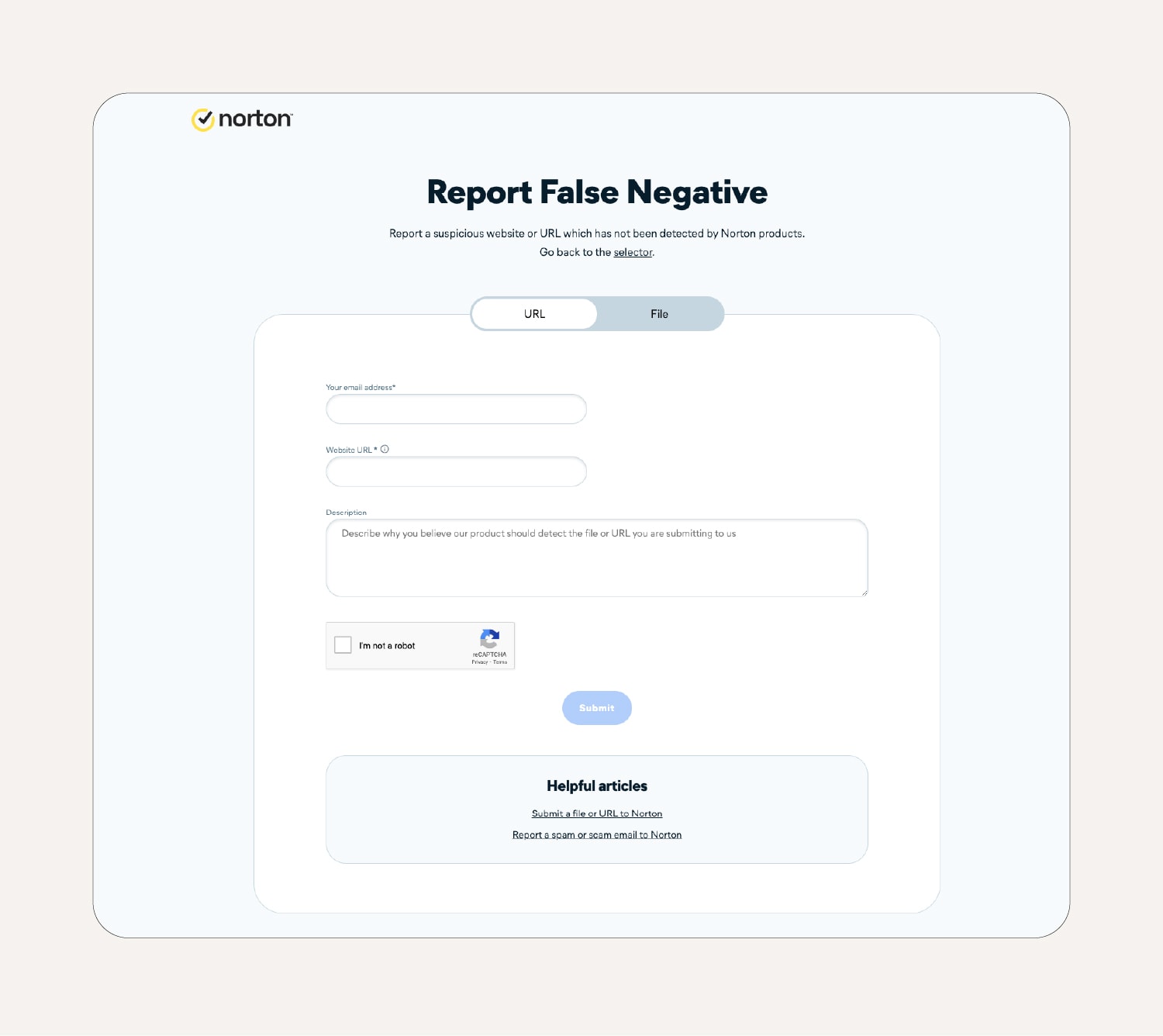
You can also enter a site’s URL on the Norton Safe Web homepage to help determine if the site is considered safe or not before you use it. And if you’ve found a site you don’t believe is safe but the tool says it is, you can submit a dispute to let Norton know.
6. Report the site to its hosting platform
You can also report a scammy website to its hosting platform. Filing a report with a hosting company encourages them to investigate and take action, up to and including deactivating the site.
You’ll need to find the hosting company and search their site for a “report abuse” option. Reporting a site may require different steps depending on the company, so follow the instructions you find for the relevant hosting company to file your report.
7. Reach out to your bank (if necessary)
If you were scammed out of money, report the fraudulent transaction to your bank as soon as possible. Your bank will open a case to investigate the situation. Depending on how you paid and your bank’s policies they may refund you the scammed money.
They may also cancel your credit or debit card or freeze your account to ensure the scammer makes no further unauthorized charges.
Even if you didn’t lose money, report internet scams to the proper authorities to help protect other users.
How to tell if a website is a scam
If you suspect a website may be a scam, check if the site is safe by assessing the following factors:
- Look for security indicators: You can look for the “tune” icon on Google Chrome and the lock icon on most other browsers to indicate a secure connection that supports HTTPS. However, the site itself could still be untrustworthy as nearly all phishing sites use HTTPS so look for the other signs listed below, too.
- Check spelling and grammar: Make sure the URL is spelled correctly and has the correct domain extension (such as .com or .org). Glaring spelling and grammar mistakes on a website may be a red flag.
- Check the contact and policies pages: Reputable websites should provide ways for users to contact them, either by email, phone, social media, or a contact form. Legitimate sites are required to make privacy and other policies public, so look for these too.
- Use a website checker: Safe browsing tools like Norton Safe Web scan URLs then let you know whether they’re safe or not.
- Use an online scam detector: If you’re not sure whether the site you’re browsing is a scam or not, you can use a free scam detector like Norton Genie. Our AI-powered scam-detection tool can identify malicious websites, text messages, and emails, helping to protect against scams, identity theft, malware, and other threats.
- Find user reviews: A quick Internet search should provide you with business information and customer reviews that you can reference. Look for any mentions of fraud or scamming on third-party sites or an abundance of overly-similar comments suggesting falsified reviews or bots.
Determining if a site is safe or a scam requires some sleuthing. If you’re ever in doubt, it’s probably best to avoid browsing or shopping there to ensure your safety.
Get protection online with Norton
Make your internet safety a priority by reporting suspicious sites to protect yourself and others from scams. And invest in online security with a service like Norton™ 360 with LifeLock™ Select to help block fake sites and protect against identity theft. That way, even if you miss the warning signs while browsing, you still have peace of mind knowing that additional layers of protection are helping to keep you safe.
FAQs about reporting website scams
Still got questions on reporting fake or scam websites? Check out these FAQs.
When should you report a website for scamming?
If you suspect a website is involved in illegal activity like fraud, phishing, or other scams, you should report it immediately. Fill out an online form to report it to the FTC and IC3.
What happens when you report a scam website?
Reporting a website for scamming will often lead to an investigation of the site and its activity, depending on the organization receiving the report. In some cases, the report leads to finding the scammer, and in others, the site is simply removed from search engines or shut down.
How can you report a website for stealing content?
You can report a website with stolen content to Google if you are the owner of the stolen material or an authorized representative of the content owner.
Can you get your money back from a website scam?
In some cases, yes. Depending on your bank and factors they lay out in their policies, they may refund you. Inform them as soon as possible after you realize you’ve been scammed.
Editorial note: Our articles provide educational information for you. Our offerings may not cover or protect against every type of crime, fraud, or threat we write about. Our goal is to increase awareness about Cyber Safety. Please review complete Terms during enrollment or setup. Remember that no one can prevent all identity theft or cybercrime, and that LifeLock does not monitor all transactions at all businesses. The Norton and LifeLock brands are part of Gen Digital Inc.
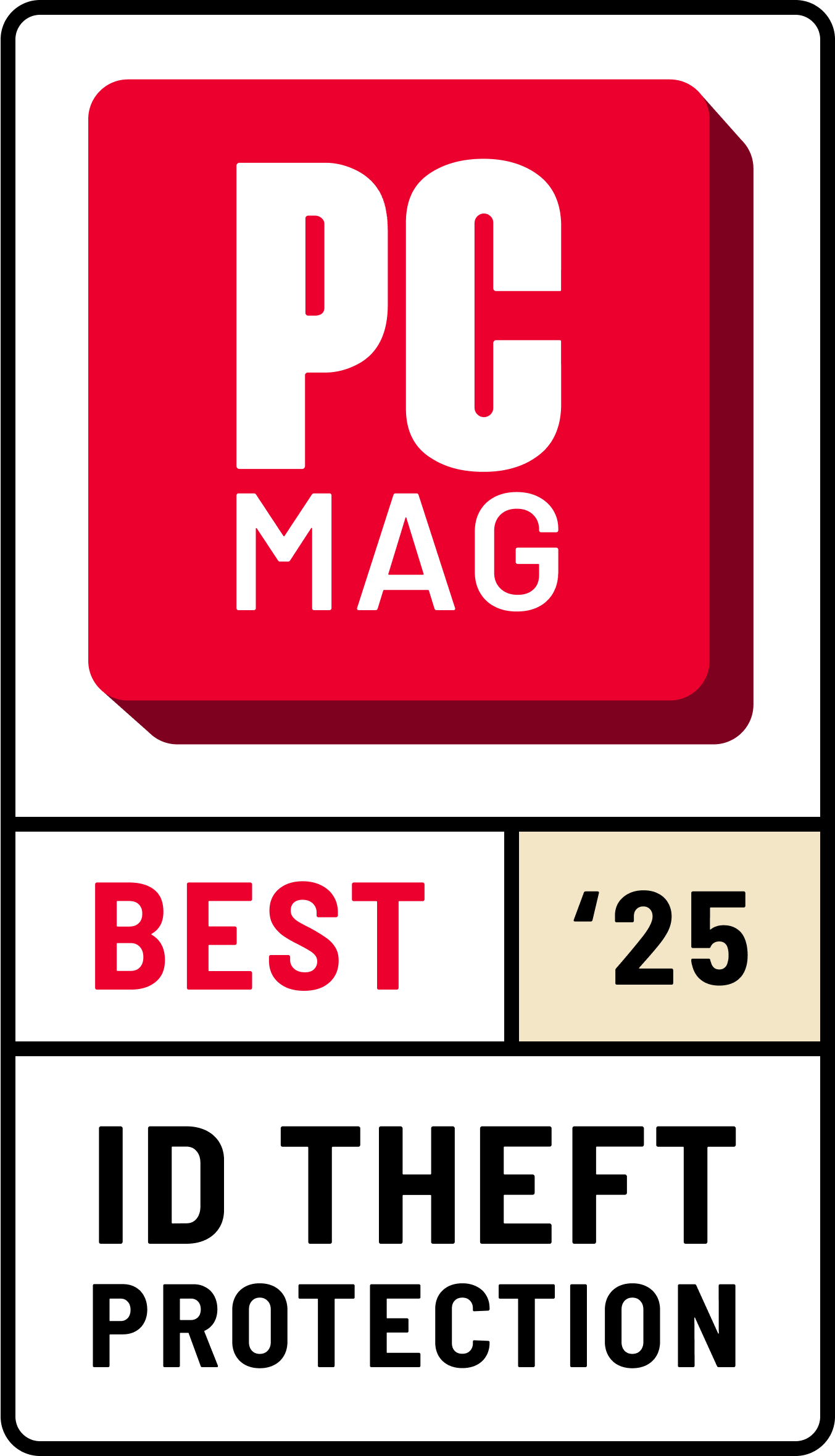






Want more?
Follow us for all the latest news, tips, and updates.